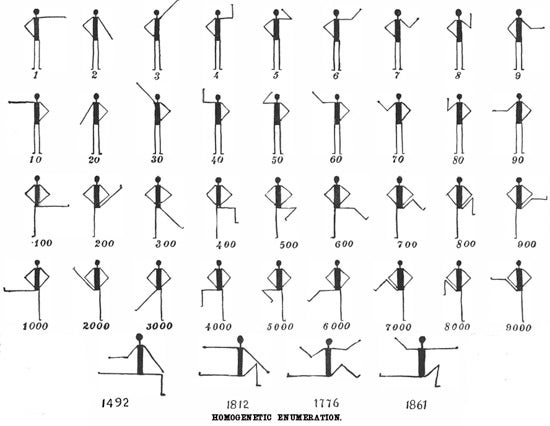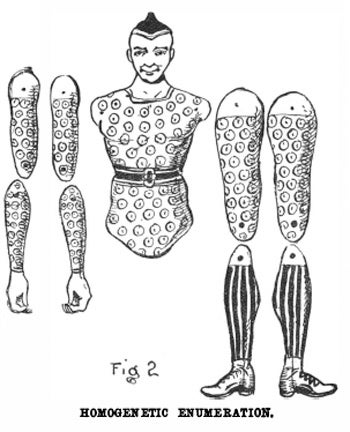This article was published in Scientific American’s former blog network and reflects the views of the author, not necessarily those of Scientific American
While this chart may look like a series of exercises or dance moves, it actually depicts a system of numeration called “Homogenetic enumeration.”

On supporting science journalism
If you're enjoying this article, consider supporting our award-winning journalism by subscribing. By purchasing a subscription you are helping to ensure the future of impactful stories about the discoveries and ideas shaping our world today.
It is similar to a semaphore flag system, except that instead of flags homogenetic enumeration uses only the limbs of the body to communicate numbers. According to the Scientific American article from July 9, 1892, it could be used as an alternative to Roman and Arabic numerals which because unlike these systems, it did not depend on written ciphers.
The left arm, used by itself, is moved into different positions to represent numbers 1-9. The right arm is used in the same manner but represents tens, while the left leg represents hundreds and the right leg thousands. “In order to represent any given number by means of these figures, it is first necessary to divide it into units, tens, hundreds, and thousands. Thus 1892 will not be represented as eighteen hundred and ninety-two, but as one thousand, right leg extended at right angles to body; eight hundred, left leg drawn up to an acute angle with the body and bent to an acute angle at the knee; ninety, right arm from shoulder at an acute angle to the body, right forearm horizontal; and two, left arm at an acute angle to the body.” The article suggests that to carry the series of numbers further, the signaler can stand on his head or wear hats of different patterns.

Figure 2 depicts a pasteboard puppet that could be cut out and jointed with thread and used to solve arithmetic problems. “In fact it may be taught to dance according to arithmetical measure and made to save a vast amount of ciphering, performing in this respect the use of the abacus.” Once you’re comfortable making the puppet dance, you can try it yourself-- next time you attempt to pick someone up on the dance floor, instead of asking for his or her number, you can signal your own.
The article acknowledges that the whole homogenetic enumeration system may seem comical and amusing, but that it opens up the question of whether the traditional Arabic numeral system could be improved upon. Judging from the lack of physical movement in places where numbers are prevalent—math class, the bank, the nightly lotto drawing—it seems like Arabic numerals have yet to fall off.